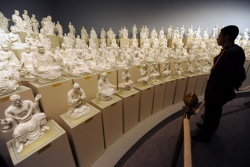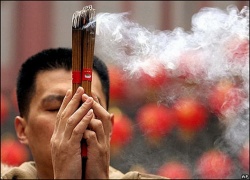Milindapañha
Records the conversation between Milinda and Nāgasena.
It is believed that the book was compiled later than the time of the conversation and that many of the recorded conversations are spurious.
For a discussion see Question of King Milinda, vol.i.xxv f.
There is a Singhalese translation to it, which is called the Saddharmādāsaya, written in the eighteenth century by a monk named Sumangala. P.L.C.274.
The Milindapañha, the eighteenth book of the Khuddaka Nikaya (according to the Burmese version of the Pali canon), consists of 7 parts as shown below. The conclusion to the Milindapañha states that it contains 262 questions, though in the editions available today only 236 can be found. Although not included as a canonical text in the traditions of all the Theravadin countries, this work is much revered throughout and is one of the most popular and authoritative works of Pali Buddhism.
Composed around the beginning of the Common Era, and of unknown authorship, the Milindapañha is set up as a compilation of questions posed by King Milinda to a revered senior monk named Nagasena. This Milinda has been identified with considerable confidence by scholars as the Greek king Menander of Bactria, in the dominion founded by Alexander the Great, which corresponds with much of present day Afghanistan. Menander's realm thus would have included Gandhara, where Buddhism was flourishing at that time.
What is most interesting about the Milindapañha is that it is the product of the encounter of two great civilizations — Hellenistic Greece and Buddhist India — and is thus of continuing relevance as the wisdom of the East meets the modern Western world. King Milinda poses questions about dilemmas raised by Buddhist philosophy that we might ask today. And Nagasena's responses are full of wisdom, wit, and helpful analogies.
Contents of the Milindapañha:
I. Background History
II. Questions on Distinguishing Characteristics (excerpts)
Characteristics of Attention and Wisdom (Miln II.1.8; Miln 32-33)
Characteristic of Wisdom (Miln II.1.14; Miln 39)
Characteristic of Contact (Miln II.3.8; Miln 60)
Characteristic of Feeling (Miln II.3.9; Miln 60)
Characteristic of Perception (Miln II.3.10; Miln 61)
Characteristic of Volition (Miln II.3.11; Miln 61)
Characteristic of Consciousness (Miln II.3.12; Miln 62)
Characteristic of Applied Thought (Miln II.3.13; Miln 62)
Characteristic of Sustained Thought (Miln II.3.14; Miln 62)
III. Questions for the Cutting Off of Perplexity (excerpts)
Transmigration and Rebirth (Miln III.5.5; Miln 71)
Soul (Miln III.5.6; Miln 71)
Non-Release From Evil Deeds (Miln III.5.7; Miln 72)
Simultaneous Arising in Different Places (Miln III.7.5; Miln 82-83)
Doing Evil Knowingly and Unknowingly (Miln III.7.8; Miln 84)
IV. Questions on Dilemmas
V. A Question Solved By Inference
VI. The Special Qualities of Asceticism
VII. Questions on Talk of Similes
Miln II.1.8: Characteristics of Attention and Wisdom {Miln 32-33}
The king asked: "Venerable Nagasena, what is the distinguishing characteristic of attention, and what is the distinguishing characteristic of wisdom?"
"Examination is the distinguishing characteristic of attention, and severing is the distinguishing characteristic of wisdom."
"How is examination the distinguishing characteristic of attention; and how is severing the distinguishing characteristic of wisdom? Give me an analogy."
"Do you know barley-reapers, your majesty?"
"Yes, venerable sir, I know them."
"How, your majesty, do barley-reapers reap barley?"
"Venerable sir, they take a sheaf of barley in the left hand, and take a sickle in the right hand, and they cut with the sickle."
"Just as, your majesty, a barley-reaper takes a sheaf of barley in the left hand, takes a sickle in the right hand, and cuts the barley, even so, your majesty, does the spiritual aspirant take hold of the mind with attention, and cut off the defilements with wisdom. Indeed thus, your majesty, examination is the distinguishing characteristic of attention, and severing is the distinguishing characteristic of wisdom."
"You are clever, venerable Nagasena."
Miln II.1.14: Characteristic of Wisdom {Miln 39}
The king asked: "Venerable Nagasena, what is the distinguishing characteristic of wisdom?"
"Previously, your majesty, I said 'severing is the distinguishing characteristic of wisdom,' and now furthermore illuminating is the distinguishing characteristic of wisdom."
"How, venerable sir, is illuminating the distinguishing characteristic of wisdom?"
"Wisdom arising, your majesty, dispels the darkness of ignorance, produces the illumination of insight, brings forth the light of knowledge, and makes manifest the noble truths; and further, the spiritual practitioner sees with complete understanding impermanence, unsatisfactoriness, and corelessness."
"Give me an analogy."
"Just as, your majesty, a person might bring a lamp into a dark house, and with the lamp lit dispel the darkness, produce illumination, show the light, and make manifest forms, so too, your majesty, wisdom arising dispels the darkness of ignorance, produces the illumination of insight, brings forth the light of knowledge, and makes manifest the noble truths; and further, the spiritual practitioner sees with complete understanding impermanence, unsatisfactoriness, and corelessness."
"You are clever, venerable Nagasena."
Miln II.3.8: Characteristic of Contact {Miln 60}
The king asked: "Venerable Nagasena, when mind consciousness arises, do contact and feeling also arise?"
"Yes, your majesty, when mind consciousness arises, contact arises, feeling arises, perception arises, volition arises, applied thought arises, and sustained thought arises. And all these mental states arise with contact in the lead."
"Venerable Nagasena, what is the distinguishing characteristic of contact?"
"The distinguishing characteristic of contact, your majesty, is touching."
"Give me an analogy."
"Just as if, your majesty, two rams are butting each other, one of these rams is to be understood as the eye, and the other as a visual object, and the coming together of the two of them is contact."
"Give me another analogy."
"Just as if, your majesty, two hands are clapping together, one of these hands is to be understood as the eye, and the other as a visual object, and the coming together of the two of them is contact."
"Give me another analogy."
"Just as if, your majesty, two cymbals are striking together, one of these cymbals is to be understood as the eye, and the other as a visual object, and the coming together of the two of them is contact."
"You are clever, venerable Nagasena."
Miln II.3.9: Characteristic of Feeling {Miln 60}
"Venerable Nagasena, what is the distinguishing characteristic of feeling?"
"The distinguishing characteristic of feeling, your majesty, is sensing; experiencing is also a distinguishing characteristic."
"Give me an analogy."
"Just as, your majesty, some man might render the king a service, and the king, being well pleased, might repay the service, such that the man on account of this service is provided and endowed with the five cords of sensual pleasure. Then the man might think to himself: 'In the past I rendered a service to the king, and now he has repaid me, on account of which I am experiencing feelings of one kind and another.'
"Or just as, your majesty, some man having performed good actions, on the dissolution of the body, after death, would reappear in a happy destination, in the heavenly world, and there he would be provided and endowed with the five cords of sensual pleasure. Then the man might think to himself: 'In the past I performed good actions, and now on account of this I am experiencing feelings of one kind and another.' So too, your majesty, the distinguishing characteristics of feeling are sensing and experiencing."
"You are clever, venerable Nagasena."
Miln II.3.10: Characteristic of Perception {Miln 61}
"Venerable Nagasena, what is the distinguishing characteristic of perception?"
"The distinguishing characteristic of perception, your majesty, is perceiving. What does one perceive? One perceives blue, yellow, red, white, and crimson. Thus, your majesty, the distinguishing characteristic of perception is perceiving."
"Give me an analogy."
"Just as, your majesty, the king's store-keeper, having entered the storehouse, might see the goods belonging to the king and would perceive blue, yellow, red, white and crimson. So too, your majesty, the distinguishing characteristic of perception is perceiving."
"You are clever, venerable Nagasena."
Miln II.3.11: Characteristic of Volition {Miln 61}
"Venerable Nagasena, what is the distinguishing characteristic of volition?"
"The distinguishing characteristic of volition, your majesty, is intending; preparation is also a distinguishing characteristic."
"Give me an analogy."
"Just as, your majesty, some man or other might prepare a poison and drink it himself, and make others drink it, then he and the others would become ill. Even so, your majesty, if some man here through volition intended some unwholesome deed, then on the dissolution of the body, after death, he would reappear in a state of deprivation, in an unhappy destination, in perdition, in hell. And those who follow his example would also on the dissolution of the body, after death, reappear in a state of deprivation, in an unhappy destination, in perdition, in hell.
"Also just as, your majesty, some man or other might mix together ghee, fresh butter, oil, honey and sugar and drink it himself, and make others drink it, then he and the others would be happy. Even so, your majesty, if some man here through volition intended some wholesome deed, then on the dissolution of the body, after death, he would reappear in a happy destination, in the heavenly world. And those who followed his example would also on the dissolution of the body, after death, reappear in a happy destination, in the heavenly world. So too, your majesty, the distinguishing characteristics of volition are intending and preparation."
"You are clever, venerable Nagasena."
Miln II.3.12: Characteristic of Consciousness {Miln 62}
The king asked: "Venerable Nagasena, what is the distinguishing characteristic of consciousness?"
"The distinguishing characteristic of consciousness, your majesty, is cognizing."
"Give me an analogy."
"Just as, your majesty, a city-superintendent sitting at the crossroads in the middle of the city could see a person coming from the eastern direction, could see a person coming from the southern direction, could see a person coming from the western direction, and could see a person coming from the northern direction, then indeed, your majesty, does a person cognize with consciousness a form he sees with the eye, cognize with consciousness a sound he hears with the ear, cognize with consciousness a scent he smells with the nose, cognize with consciousness a taste he savors with the tongue, cognize with consciousness a touch he feels with the body, and cognize with consciousness a mental state he cognizes with the mind. Indeed thus, your majesty, the distinguishing characteristic of consciousness is cognizing."
"You are clever, venerable Nagasena."
Miln II.3.13: Characteristic of Applied Thought {Miln 62}
"Venerable Nagasena, what is the distinguishing characteristic of applied thought?"
"The distinguishing characteristic of applied thought, your majesty, is fixing one's mind on an object."
"Give me an analogy."
"Just as, your majesty, a carpenter might fix a well-prepared piece of wood into a joint, so too, your majesty, the distinguishing characteristic of applied thought is fixing one's mind on an object."
"You are clever, venerable Nagasena."
Miln II.3.14: Characteristic of Sustained Thought {Miln 62}
"Venerable Nagasena, what is the distinguishing characteristic of sustained thought?"
"The distinguishing characteristic of sustained thought, your majesty, is continual examination."
"Give me an analogy."
"Just as, your majesty, when a gong is struck and continues resounding afterwards, indeed so the striking is to be understood as applied thought, and the continuance of the resounding as sustained thought."
"You are clever, venerable Nagasena."








